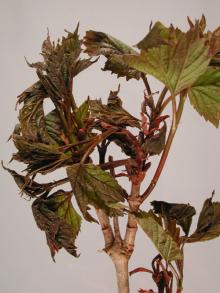Cause Pseudomonas syringae pv. viburni, a bacterium that can be a problem in cool, wet springs. Pseudomonas syringae pv. syringae may also occur on viburnum in the PNW. Although the bacteria survive on the outside of the plant they must get inside and multiply in the space between plant cells (apoplast) to cause disease. These pathogenic bacteria inject several proteins and small-molecule toxins to get past host immune mechanisms. Once inside, the bacteria induce a watery, nutrient rich environment between the plant cells where they can multiply and continue colonization of the plant tissues. Bacteria also produce a protein that acts as an ice nucleus, increasing frost wounds that bacteria easily colonize and expand.
Symptoms Spots are at first water soaked, then turn brown and irregular in shape. Oregon observations are that spots may be angular. Margins frequently develop a bacterial exudate. Numerous spots during early shoot growth can deform leaves. Stem lesions are elongate and generally not as obvious. Severe infections can result in a shoot dieback.
Cultural control
- Remove and destroy infected leaves or plant debris.
- Space plants for good air circulation.
- Avoid high nitrogen fertility that promotes excessive growth.
- Protect plants from extremes of weather early in the season. Plastic shelters have been as good as or better than chemical methods against the same disease on other crops.
- Cultivars reportedly resistant include V. x burkwoodii 'Mohawk', V. x carlcephalum 'Cayuga', V. lantana 'Mohican', and V. rhytidophyllum 'Alleghany'.
Chemical control Bacteria resistant to copper products have been detected in many nurseries. Limit the use of any one group during crop production.
- Agri-Mycin 50 at 5.3 to 16 oz/100 to 300 gal water/A. Tolerant strains of bacteria easily develop with repeated use of this product. Alternate with other bactericides to prevent or delay buildup of tolerant strains. Group 25 fungicide. 12-hr reentry.
- Badge X2 at 1.5 to 2 lb/A. Group M1 fungicide. 48-hr reentry. O
- CuPRO 5000 at 1.5 to 5 lb/A but only up to 2 lb/A when new growth is present. Group M1 fungicide. 48-hr reentry.
- FireWall 50 WP at 1.36 oz/25 gal water. Group 25 fungicide. 12-hr reentry.
- Junction at 1.5 to 3.5 lb/A. Group M1 + M3 fungicide. 48-hr reentry.
- Monterey Liqui-Cop at 3 Tbsp/gal water. H
References Bradbury, J.F. 1986. Guide to Plant Pathogenic Bacteria. CAB International Mycological Institute.
Scheck, H.J., Canfield, M.L., Pscheidt, J.W., and Moore, L.W. 1997. Rapid evaluation of pathogenicity in Pseudomonas syringae pv. syringae with a lilac tissue culture bioassay and syringomycin DNA probes. Plant Disease 81:905-910.




